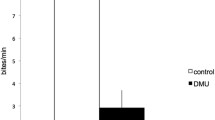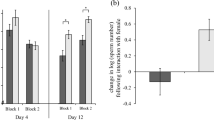Abstract
Hormones play an important role in the regulation of reproductive behavior. Here, we examined the effects of the fatty acid derivative prostaglandin F2α (PGF2) on female sexual behavior as well as the interaction between PGF2-induced mating behavior with male courtship display in the lek-breeding African cichlid fish, Astatotilapia burtoni. In a two-way choice paradigm, we found that nonreproductive females preferred to associate with smaller, less aggressive males over larger, more aggressive males. However, PGF2-treated females dramatically reversed their preference to larger males. In a second experiment, PGF2 treatment dramatically increased sexual behavior in nonreproductive females as measured by time spent in the bower of the stimulus male, even when the female and the stimulus male were separated by a transparent divider. This effect was even more pronounced when the stimulus males were exposed to the putative female pheromone 17α,20β-progesterone (17α,20β-P). Under full-contact conditions, only PGF2-treated females visited a stimulus male’s bower, where they even displayed circling behavior usually only seen during spawning. Interestingly, male performance prior to PGF2 treatment predicted female sexual response. Our study demonstrates the importance of PGF2 in the control of female reproductive behavior in interaction with male performance.




Similar content being viewed by others
References
Andersson M (1994) Sexual selection. Princeton University Press, Princeton
Byers J, Hebets E, Podos J (2010) Female mate choice based upon male motor performance. Anim Behav 79:771–778
Baerends GP, Baerends-Van Roon JM (1950) An introduction to the study of the ethology of cichlid fishes. Behaviour Suppl 233–366
Baldauf SA, Kullmann H, Winter S, Thünken T, Bakker TCM (2009) Computer animation as a tool to study preferences in the cichlid Pelvicachromis taeniatus. J Fish Biol 75:738–746
Benjamini Y, Hochberg Y (1995) Controlling the false discovery rate: a practical and powerful approach to multiple testing. J Roy Stat Soc B 57:289–300
Burne TH, Murfitt PJ, Johnston AN (2001) PGF(2alpha)-induced nest building and choice behavior in female domestic pigs. Appl Anim Behav Sci 73:267–279
Candolin U (2003) The use of multiple cues in mate choice. Biol Rev 78:575–595
Clement TS, Grens KE, Fernald RD (2005) Female affiliation preference depends on reproductive state in the African cichlid fish, Astatotilpia burtoni. Behav Ecol 16:83–88
Cole K, Stacey NE (1984) Prostaglandin induction of spawning behavior in Cichlasoma bimaculatum (Pisces Cichlidae). Horm Behav 18:235–248
Cole TB, Stacey NE (2006) Olfactory responses to steroids in an African mouth-brooding cichlid, Haplochromis burtoni (Günther). J Fish Biol 68:661–680
Collins S (1994) Male displays: cause or effect of female preference? Anim Behav 48:371–375
Crews D (2005) Evolution of neuroendocrine mechanisms that regulate sexual behavior. Trends Endocrin Met 16:354–361
DeFraipont M, Sorensen PW (1993) Exposure to the pheromone 17a,20b-dihydroxy-4-pregnen-3-one enhances the behavioral spawning success, sperm production, and sperm motility of male goldfish. Anim Behav 46:245–256
Diakow C, Nemiroff A (1981) Vasotocin, prostaglandin, and female reproductive behavior in the frog, Rana pipiens. Horm Behav 15:86–93
Fernald RD, Hirata NR (1977) Field study of Haplochromis burtoni quantitative behavioral observations. Anim Behav 25:964–975
Forlano PM, Bass AH (2011) Neural and hormonal mechanisms of reproductive-related arousal in fishes. Horm Behav 59:616–629
Gordon NM, Gerhardt HC (2009) Hormonal modulation of phonotaxis and advertisement-call preferences in the gray treefrog (Hyla versicolor). Horm Behav 55:121–127
Grone BP, Carpenter RE, Lee M, Maruska KP, Fernald RD (2012) Food deprivation explains effects of mouthbrooding on ovaries and steroid hormones, but not brain neuropeptide and receptor mRNAs, in an African cichlid fish. Horm Behav 62:18–26
Guillette LJ Jr, Gross TS, Matter JH, Palmer BD (1991) Arginine vasotocin-induced prostaglandin synthesis in vitro by the reproductive tract of the viviparous lizard Sceloporus jarrovi. Prostaglandins 39:39–51
Haselton MG, Mortezaie M, Pillsworth EG, Bleske-Rechek A, Frederick DA (2007) Ovulatory shifts in human female ornamentation: near ovulation, women dress to impress. Horm Behav 51:40–45
Hertelendy F, Yeh M, Biellier HV (1974) Induction of oviposition in the domestic hen by prostaglandins. Gen Comp Endocrinol 22:529–531
Hofmann HA (2003) Functional genomics of neural and behavioral plasticity. J Neurobiol 54:272–282
Hofmann HA, Fernald RD (2001) What cichlids tell us about the social regulation of brain and behavior. J Aguariculture Aquat Sci 9:17–31
Hofmann HA, Benson ME, Fernald RD (1999) Social status regulates growth rate: consequences for life-history strategies. P Natl Acad Sci USA 95:14171–14176
Jennions MD, Petrie M (1997) Variation in mate choice and mating preferences: a review of causes and consequences. Biol Rev 72:283–327
Johnstone RA (1995) Sexual selection, honest advertisement and the handicap principle: reviewing the evidence. Biol Rev 70:1–65
Jones AG, Ratterman NL (2009) Mate choice and sexual selection: what have we learned since Darwin? P Natl Acad Sci USA 106:10001–10008
Kidd MR, O’Connell LA, Kidd CE, Chen CW, Fontenot MR, Sepeda D, Williams SJ, Hofmann HA (2013) Prostaglandin F2α mediates female mate choice in an African cichlid. Gen Comp Endocrinol 180:56–63
Kobayashi M, Stacey NE (1993) Prostaglandin-induced female spawning behavior in goldfish (Carassius auratus) appears independent of ovarian influence. Horm Behav 27:38–55
Kobayashi M, Sorensen PW, Stacey NE (2002) Hormonal and pheromonal control of spawning behavior in the goldfish. Fish Physiol Biochem 26:71–84
Kokko H, Brooks R, Jennions MD, Morley J (2003) The evolution of mate choice and mating biases. Proc R Soc Lond B Biol Sci 270:653–664
Kraaijeveld K, Kraaijeveld-Smit FJL, Maan ME (2011) Sexual selection and speciation: the comparative evidence revisited. Biol Rev 86:367–377
Liley NR, Tan ESP (1985) The induction of spawning behavior in Puntius gonionotus (Bleeker) by treatment with prostaglandin PGF2α. J Fish Biol 26:491–502
Lomborg JP, Toft S (2009) Nutritional enrichment increases courtship intensity and improves mating success in male spiders. Behav Ecol 20:700–708
Maan ME, Seehausen O, Soderberg L, Johnson L, Ripmeester AP, Mrosso HDJ, Taylor MI, van Dooren TJM, van Alphen JJM (2004) Intraspecific sexual selection on a speciation trait, male coloration, in the Lake Victoria cichlid Pundamilia nyererei. Proc R Soc Lond B 271:2445–2452
Macintosh DJ, Little DC (2005) Nile tilapia (Oreochromis niloticus). In: Bromage NR, Roberts RJ (eds) Broodstock management and egg and larval quality. Blackwell, London, pp 277–320
Maruska KP, Levavi-Sivan B, Biran J, Fernald RD (2011) Plasticity of the reproductive axis during social ascent in an African cichlid fish: I—pituitary gonadotropins. Endocrinology 152:281–290
McCarthy MM, Bare JE, vom Saal FS (1986) Infanticide and parental behavior in wild female house mice: effects of ovariectomy, adrenalectomy and administration of oxytocin and prostaglandin F2 alpha. Physiol Behav 36:17–23
McElroy DM, Kornfield I (1990) Sexual selection, reproductive behavior, and speciation in the mbuna species flock of Lake Malawi (Pisces: Cichlidae). Environ Biol Fish 28:285–294
Munakata A, Kobayashi M (2010) Endocrine control of sexual behavior in teleost fish. Gen Comp Endocrinol 165:456–468
Oshima Y, Kang IJ, Kobayashi M, Nakayama K, Imada N, Honjo T (2003) Suppression of sexual behavior in male Japanese medaka exposed to 17b-estradiol. Chemosphere 50:429–436
Ramsey ME, Wong RY, Cummings ME (2011) Estradiol, reproductive cycle and preference behavior in a northern swordtail. Gen Comp Endocrinol 170:381–390
Ramsey ME, Maginnis TL, Wong RY, Brock C, Cummings ME (2012) Identifying context-specific gene profiles of social, reproductive and mate preference behavior in a fish species with female mate choice. Front Neurogenomics 6:62
Renn SCP, Aubin-Horth N, Hofmann HA (2008) Fish & chips: functional genomics of social plasticity in an African cichlid fish. J Exp Biol 211:3041–3056
Renn SCP, Carelton J, Magee H, Nguyen ML, Tanner AC (2009) Maternal care and altered social phenotype in a recently collected stock of Astatotilapia burtoni cichlid fish. Integr Comp Biol 49:660–673
Renn SCP, Fraser EJ, Aubin-Horth N, Trainor BC, Hofmann HA (2012) Females of an African cichlid fish display male-typical social dominance behavior and elevated androgens in the absence of males. Horm Behav 61:496–503
Robinson GE, Fernald RD, Clayton DF (2008) Genes and social behavior. Science 322:896–900
Santangelo N (2005) Courtship in the monogamous convict cichlid; what are individuals saying to rejected and selected mates? Anim Behav 69:143–149
Schmidt RS (1985) Prostaglandin-induced mating call phonotaxis in female American toad: facilitation by progesterone and arginine vasotocin. J Comp Physiol A 156:823–829
Slater DM, Zervou S, Thornton S (2002) Prostaglandins and prostanoid receptors in human pregnancy and parturition. J Soc Gynecol Investig 9:118–124
Stacey NE (1981) Hormonal regulation of female reproductive behavior in fish. Am Zool 21:305–316
Stacey NE (2003) Hormones, pheromones and reproductive behavior. Fish Physiol Biochem 28:229–235
Tokarz RR, Crews D (1981) Effects of prostaglandins on sexual receptivity in the female lizard, Anolis carolinensis. Endocrinology 109:451–457
Villars TA, Hale N, Chapnick D (1985) Prostaglandin-F2a stimulates reproductive behavior of female paradise fish (Macropodus opercularis). Horm Behav 19:21–35
Weintraub AS, Kelley DB, Bockman RS (1985) Prostaglandin E2 induces receptive behaviors in female Xenopus laevis. Horm Behav 19:386–399
Whittier JM, Crews D (1986) Effects of prostaglandin F2 alpha on sexual behavior and ovarian function in female garter snakes (Thamnophis sirtalis parietalis). Endocrinology 119:787–792
Wilczynski W, Lynch K (2011) Female sexual arousal in amphibians. Horm Behav 59:630–636
Yamamoto N, Oka Y, Kawashima S (1997) Lesions of gonadotropin-releasing hormone-immunoreactive terminal nerve cells: effects on the reproductive behavior of male dwarf gouramis. Neuroendocrinology 65:403–412
Acknowledgments
We thank Ryan Wong for helpful comments on earlier versions of this manuscript and members of the Hofmann laboratory for discussions. We also thank the associate editor Kai Lindström and an anonymous reviewer for helpful comments on the manuscript. This work was supported by NSF grant 0843712, the Alfred P. Sloan Foundation, and a Dwight W. and Blanche Faye Reeder Centennial Fellowship in Systematic and Evolutionary Biology and Institute for Cellular and Molecular Biology Fellowship to HAH.
Ethical standards
All work was carried out in compliance with the Institutional Animal Care and Use Committee at The University of Texas at Austin. All the experiments comply with current laws in the USA.
Author information
Authors and Affiliations
Corresponding author
Additional information
Communicated by K. Lindström
Michael R. Kidd and Peter D. Dijkstra contributed equally to the work.
Rights and permissions
About this article
Cite this article
Kidd, M.R., Dijkstra, P.D., Alcott, C. et al. Prostaglandin F2α facilitates female mating behavior based on male performance. Behav Ecol Sociobiol 67, 1307–1315 (2013). https://doi.org/10.1007/s00265-013-1559-9
Received:
Revised:
Accepted:
Published:
Issue Date:
DOI: https://doi.org/10.1007/s00265-013-1559-9




